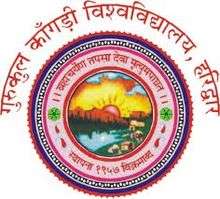Gurukul Kangri Vishwavidyalaya
Coordinates: 29°55′18″N 78°7′39″E / 29.92167°N 78.12750°E
 | |
| Type | Public |
|---|---|
| Established | 1902 |
| Chancellor | Dr. Ram Prakash |
| Vice-Chancellor | Prof. Surendra Kumar |
| Students | 4000+ |
| Location | Haridwar, Uttarakhand, India |
| Campus | Rural, Urban |
| Colours | Saffron and White |
| Nickname | GKV |
| Affiliations | UGC |
| Website |
www |
Gurukula Kangri University or Gurukul Kangri Vishwavidyalaya ('गुरुकुल कांगड़ी विश्वविद्यालय') is a university in the city of Haridwar in the Indian state of Uttarakhand.It is one of the best ayurvedic college.
It is on the bank of the Ganges about 6 km from Hardwar and about 200 km from Delhi.
History
Gurukula Kangri Vishwavidyalaya was founded on 4 March 1902 by the Arya Samaj missionary Swami Shraddhanand, who was a follower of Dayananda Saraswati, with the sole aim to revive the ancient Indian gurukula system of education. This institution was established with the objective of providing an indigenous alternative to Lord Macaulay's education policy by imparting education in the areas of Vedic literature, Indian philosophy, Indian culture, modern sciences, and research.
It is a deemed to be university fully funded by the UGC/Govt. of India.
The Arya Samaj advocated women’s education. As part of its policies for the upliftment of women in the country, Kanya Gurukula Campus, Dehradun was established in 1922 by Acharya Ramdevji as a second campus of women’s education. To give real shape to the dreams of Swami Shraddhanandaji, Kanya Gurukula Campus, Hardwar was established in 1993.
Gurukula has witnessed many distinguished guests. A few of them are C. F. Andrews, Ramsay MacDonald, Mahatma Gandhi, Pt. Madan Mohan Malaviya, Dr. Rajendra Prasad, Dr Radha Krishnan, Sh.Jamnalal Bajaj, Dr. Munje, Sadhu Vaswani, Pt. Jawahar Lal Nehru, Smt. Indira Gandhi and Sh. Gyani Jail Singh, Sh. L.K. Advani and in 2011 Smt. Meira Kumar, speaker Lok Sabha visited.
The impetus for the foundation was found in the teachings and activities of Dayananda Saraswati, founder of the Arya Samaj. The first foundation brick was laid down in Gujrawala, Punjab. During India Partition Swami ji searched for a suitable palace in India according to the imagination of Dayananda Saraswati as mentioned in Satyarth Prakash. The site of Kangri village, Bijnor district, was flooded when the river changed course in 1924; the new (present) campus was built subsequently.
Campuses
The university has separate campuses for men and women.
- Main Campus, Gurukul Kangri University, Haridwar (males)
- Kanya Gurukul Mahavidhyalaya, Haridwar (females)
- Kanya Gurukul Mahavidhyalaya, Dehradun (females)
- Faculty of Engineering and Technology, Haridwar (males)
Faculties
The university provides education in modern sciences, technology and management, as well as covering traditional subjects such as Vedic literature, Indian philosophy and culture.
The Faculty of Life Science provides B.Sc., M.Sc. and Ph.D. degrees in the following subjects:
- Botany (B.Sc./Ph.D)
- Zoology (B.Sc./Ph.D)
- Industrial Microbiology/Microbiology (B.Sc, M.Sc. and Ph.D)
- Environmental Science
The Faculty of Engineering and Technology provides B.Tech. degrees in the following subjects:
- Computer Science and Engineering
- Electrical Engineering
- Electronics and Communication Engineering
- Mechanical Engineering
The Faculty of Management Studies provides the following PG degree programs and now UG program (2013 onwards) in the areas of management, finance and economics:
- Master of Business Administration (with electives in HR, Marketing, Finance, Production & IT)
- Master of Business Finance (with electives in Investment, Banking & Insurance)
- Master of Business Economics
- Bachelor of Business Administration
- Master of Computer Application
Research and consulting facilities are available in the department.
The Vedic Path
The Vedic Path is a peer-reviewed international quarterly journal of English published by the university. It is indexed in the Guide to Indian Periodical Literature. It was originally published as The Vedic Magazine from 1906 to 1935 and thereafter it was named as The Vedic Path.
The journal aims at promoting Indian knowledge tradition, Indian and Western literary theories, and their applications to literature. The research papers dealing with any aspect of these areas are published; preference is given to research papers of a comparative or interdisciplinary nature.
Notable alumni
- Chetan Anand
- Nawazuddin Siddiqui
- Baba Ramdev
- Sudhakar Chaturvedi
Achievements
- Deemed University Status: The distinguished services of this institution to the nation were recognized when it was given the status of Deemed to be University in 1962 by University Grants Commission.
- Four-Star Status: National Accreditation and Assessment Council (NAAC) has awarded four-star status to the Vishwavidyalaya in 2002.
- Centenary Year: Vishwavidyalaya celebrated 2002 as its centenary year. The vishwavidyalaya has had phenomenal growth over the past 100 years and now offers 20 UG courses and 17 PG courses. Research programmes leading to the degree of Ph.D. are being run in Vedic literature, Sanskrit literature, Philosophy, Hindi, English, [Pharmacy [B.Pharm]], Psychology, Ancient Indian History Culture & Archaeology, Environmental Science, Physics, Chemistry, Mathematics, Human Consciousness and Yogic Sciences, Botany, Zoology, Microbiology, Computer sciences and Management Studies.
- Membership: Gurukula Kangri Vishwavidyalaya is a Registered autonomous institute. All the degrees conferred by the vishwavidyalaya are recognized by UGC and AICTE wherever required. Gurukula Kangri Vishwavidyalaya is a proud member of the Association of Indian Universities and Association of Commonwealth Universities.
References
| Wikisource has original text related to this article: |
| Wikisource has original text related to this article: |
Further reading
- Gurukul Kangri Vishwavidyalaya, Haridwar ka Sau Varsh ka Itihas, by Jayadev Vedalankar. Bhartiya Vidya Prakashan, Delhi, 2002.
- Speech at Gurukul, Hardwar (8 April 1915). Collected Works, by Gandhi. Publications Division, Ministry of Information and Broadcasting, Govt. of India, 1958. v.13. Page 46.